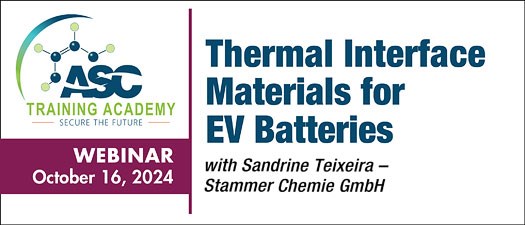Thermal Interface Materials for EV Batteries
You will receive an email with a link to the GoToWebinar form once your registration is processed
Event Details
Abstract:
The battery lifetime, the performance of charge and discharge and the thermal Runaway safety risk are some of the concerns that Thermal Interface Material (TIM) can address. To achieve an efficient thermal management during the vehicle operating life, a high thermal conductivity value is not sufficient, material properties as (1) adhesion strength, (2) coefficient of thermal expansion and (3) elastomeric modulus will secure the interface contact which is critical to reduce the interfacial thermal resistivity and maintain a stable heat flow during the battery pack lifetime. The change from the modular design (cell to pack) to structural pack design (cell to chassis) is addressed in the Webinar to highlight the importance of the design on the material selection. Indeed, the original design has seen a large adoption of Gap filler as TIM, the new design sees a shift to adhesive TIM. Achieving a high thermally conductive value while maintaining, both durable adhesion and a stable elastomeric modulus, is a material technology challenge. An efficient combination of fillers combined with the proper chemistry can provide the expected performance. After an introduction on the role of silicone materials in thermal management and the formulation options, this Webinar describes and compares several thermal material solutions for electric vehicles Battery pack.
Objectives:
- Learn how a passive thermal management system enhances performance and safety of battery packs.
- Understand the role and benefits of silicone materials in thermal management
- Learn to identify a suitable thermal material in respect of form, physicals properties and processability tailored to the application design (battery pack) and prevent the usual focus on the thermal conductivity as the sole selection criteria.
- Develop a good understanding of the TIM (thermal interface material) performance optimisation possibilities.
- Learn on the impact of fillers on TIM performance
Agenda:
- Introduction on the role of silicone materials in thermal management
- The formulation options: comparison of different filler types and combination performances
- Maintaining an interfacial surface contact to assure heat flow stability during assembly lifetime
- The design impact on the TIM selection – Illustration: from the modular design (cell to pack) to structural pack design (cell to chassis)
Who Should Attend:
This is an ideal webinar for professinals in technical roles serving in the assembly, transportation, electronics and battery managements markets. Technology managers, R&D scientists, chemists, technical service, manufacturing and process engineering folks will gain from attending this webinar.
SPEAKER
Sandrine Teixeira
Stammer Chemie GmbH
Sandrine Teixeira de Carvalho obtained a M.Sc. in Chemical Engineering from the Meurice Engineering High School of Brussels in 1994. She has worked at Dow Corning and Dow during 25 years as Application Engineer for the Automotive market. Ms. Teixeira’s career is focused on identifying and translating the need of the Electronic Automotive Industry for protection and assembly to advanced materials. She has acquired a deep global market knowledge in automotive electronics. She strongly contributed to the development and characterization of a series of novel silicone materials for both assembly and thermal applications, with a specific focus on thermal interface materials. Aside her Global Key Account Technical Leader role to Automotive Tier 1 and OEM, she was the representative of the Application Engineering function at the Transportation Market Leader Team. Her mission was to propose Advanced Assembly Technical Roadmaps aligned to automotive industry needs for Dow. Sandrine Teixeira de Carvalho’s worked on the population of a healthy commercial portfolio for innovative materials enabling robust, reliable, and cost-efficient designs of electronics modules with tailored dispense and stable flow attributes. She is currently working as a freelance consultant in Stammer Chemie to support Professionals with polymer technical solutions for electronic applications.

